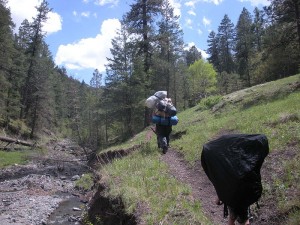 Change is hard, especially if what you’re doing works. And doubly so if it’s been working for 40 years or so.
Change is hard, especially if what you’re doing works. And doubly so if it’s been working for 40 years or so.
If you started backcountry hiking in the 70s or 80s, you have notions about what constitutes a robust and well-stocked pack. And you probably scoff at younger people who wander off for a week in the woods with a flimsy, frame-less sack that wouldn’t hold a middle-schooler’s textbooks.
The world is changing, though, and those old giant packs are showing up at garage sales, next to CRT monitors and phones for your land line. The Oregonian has a story on the shift to feather-light gear…and another piece on the old-timers who are resisting the transition.
The first story is a brief, Oregon-centric history of ultralight camping, starting with the remarkable Ray Jardine; the second compares the packs of an experienced 62-year-old and an experienced 29-year-old. The former heads out for a 50-mile week with 57 pounds strapped to his aged back (before food and water); the latter bounds “from rock to rock” carrying a mere seven pounds of base weight.
Each has his reasons. The older hiker is concerned about safety and security—hence the redundancies, like six sources of light—in part because it’s a wise strategy to think about safety first and in part because young people wear recklessness so much better than older people. But all that weight comes at a cost, which might be fewer and much shorter hikes as one ages.
Those limitations can fall away when an older hiker makes the move to ultralight gear, says one equipment maker: “I have received many excited letters from graying outdoor enthusiasts who had resigned themselves to giving up backpacking for good, only to find out with ultralight gear and techniques they were once again able to spend time in the backcountry they loved.”
If you want to follow the light—and give your back and knees a break—a good place to start is with Jardine’s web page. Or check out this post from the Appalachian Mountain Club’s gear guru, the estimable Matt Heid, who overviews five small but still “awesome” ultralight gear companies.
Go ahead. Read about Tarptent’s one-person, 24.5-ounce Contrail shelter ($199) or the two-person, 41-ounce Double Rainbow $275). Or Western Mountaineering’s 16-ounce HighLite sleeping bag ($295). That’s how it starts. Before long you’ll be second-guessing that old pack. Then weighing it. Then putting a trail-running shoe in one hand and your big old waffle-stompers in the other. And before long you’ll be cutting down the handle on your toothbrush and hiking without underwear. It’s a slippery, slippery slope. And your wobbly knees will thank you all the way down.
Photo of non-ultralight hikers via Wikimedia Commons.









